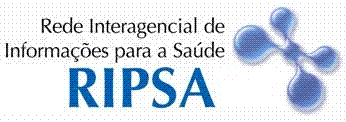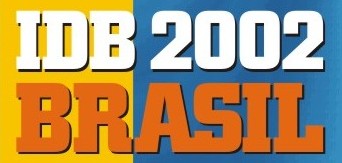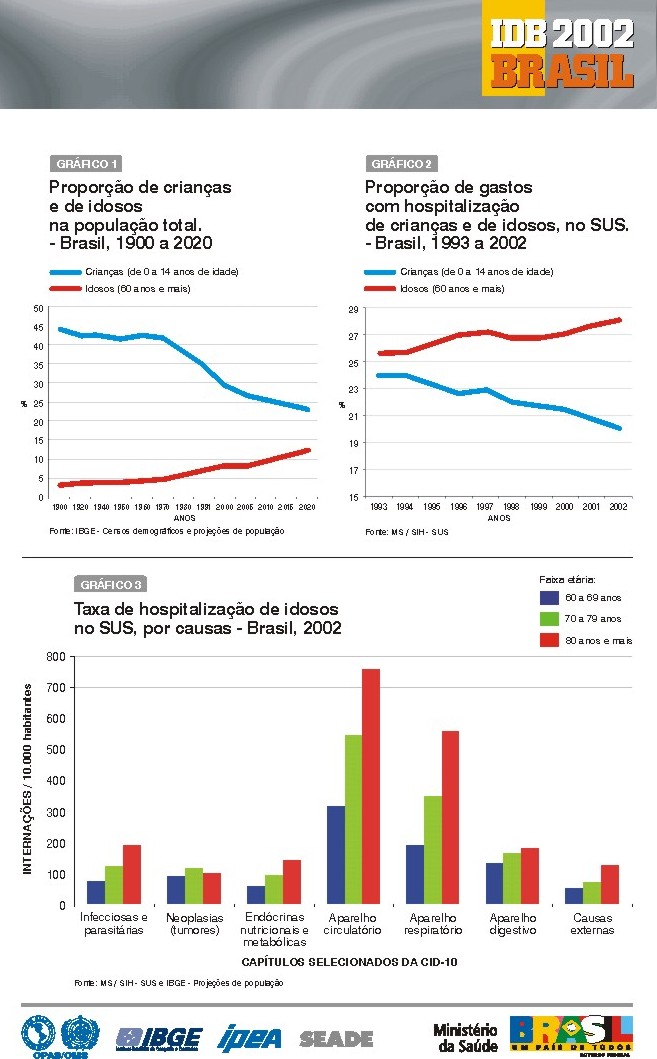|
|

|

| |
|
As informações do IDB são atualizadas anualmente. Sugerimos consultar a versão mais recente (http://www.datasus.gov.br/idb). |
|
|

|

| |
|
As informações do IDB são atualizadas anualmente. Sugerimos consultar a versão mais recente (http://www.datasus.gov.br/idb). |
 Since 2000 edition the IDB publication
has been dedicated to a particularly relevant issue of public health in
Brazil. The two previous editions have addressed infant mortality
and violence. For the IDB - 2002 edition, the theme selected has
been elderly health, which deserves growing attention for the planning
of public health activities.
Since 2000 edition the IDB publication
has been dedicated to a particularly relevant issue of public health in
Brazil. The two previous editions have addressed infant mortality
and violence. For the IDB - 2002 edition, the theme selected has
been elderly health, which deserves growing attention for the planning
of public health activities.
This edition's front cover presents a map with the spatial distribution of the proportion of elderly over total population per micro region in Brazil, 2000. The highest concentration of elderly people is located in the Brazilian coastline from the Southern state of Rio Grande do Sul to the Northeastern state of Piauí. In contrast, in the Northern region of the country, the population is younger, probably due to high fertility rates. In the countryside areas of the country, the age group distribution should be analyzed considering the increase in life expectancy and migration of population in working age in search of better working conditions.
 In the back cover, other elderly
indicators are presented. Graph 1 demonstrates a progressive increase in
the proportion of elderly over total population during the past hundred
years, particularly since the seventies. In contrast, a decrease in the
proportion of those aged 15 and younger can be noticed. A similar trend
can be observed for hospital expenses in the Sistema Único de
Saúde (SUS) - Brazilian Public Health Service, which are gradually
shifting towards medical care provided to the elderly (graph 2). Also, hospitalization
expenses have increased with the age of the patients for most of the International
Classification of Diseases (ICD) groups of diseases, except for neoplasms
among elderly over 80 years of age (graph 3).
In the back cover, other elderly
indicators are presented. Graph 1 demonstrates a progressive increase in
the proportion of elderly over total population during the past hundred
years, particularly since the seventies. In contrast, a decrease in the
proportion of those aged 15 and younger can be noticed. A similar trend
can be observed for hospital expenses in the Sistema Único de
Saúde (SUS) - Brazilian Public Health Service, which are gradually
shifting towards medical care provided to the elderly (graph 2). Also, hospitalization
expenses have increased with the age of the patients for most of the International
Classification of Diseases (ICD) groups of diseases, except for neoplasms
among elderly over 80 years of age (graph 3).
This edition presents concise information that can be fully accessed at the SUS Department of Informatics (DATASUS) web page (www.datasus.gov.br). DATASUS is the Ministry of Health's institution responsible for gathering data provided by the official sources of information detailed in the IDB. This site also provides different levels of aggregation of the same indicators, other health indicators that are not presented in the publication, as well as the original data. Technical notes for each and every indicator can also be accessed.
Data presented here refer to the most recent year for which information is available, and the sources of data include different specialized institutions from the Ministry of Health, such as Fundação Nacional de Saúde (Funasa) - National Health Foundation and Agência Nacional de Saúde Suplementar (ANS) - National Agency for Supplementary Health, and other organizations such as Instituto Brasileiro de Geografia e Estatística (IBGE) - Brazilian Institute for Geography and Statistics, Instituto de Pesquisa Econômica Aplicada (IPEA) - Institute of Applied Economic Research, Coordenação Geral de Estatística e Atuária do Ministério da Previdência Social - General Coordination for Statistics of the Social Security Ministry; and the Fundação Sistemas de Análise de Dados do Estado de São Paulo (SEADE) - São Paulo State Data Analysis Systems Foundation.
REDE INTERAGENCIAL DE INFORMAÇÕES
PARA A SAÚDE
INTERAGENCY NETWORK FOR HEALTH INFORMATION - RIPSA
Ministério da Saúde - Ministry of
Health
Secretaria Técnica da Ripsa - Ripsa technical secretariat
Contact: http://formsus.datasus.gov.br/site/formulario.php?id_aplicacao=6131
NOTATION
(-): Numeric data equals 0 and is not resulted from round off
(...): Numeric data not available
(0; 0,0; 0,000): Numeric data equals 0, resulting from rounding off of a
positive number
(x): Numeric data excluded from the IDB 2002
(..): Does not apply